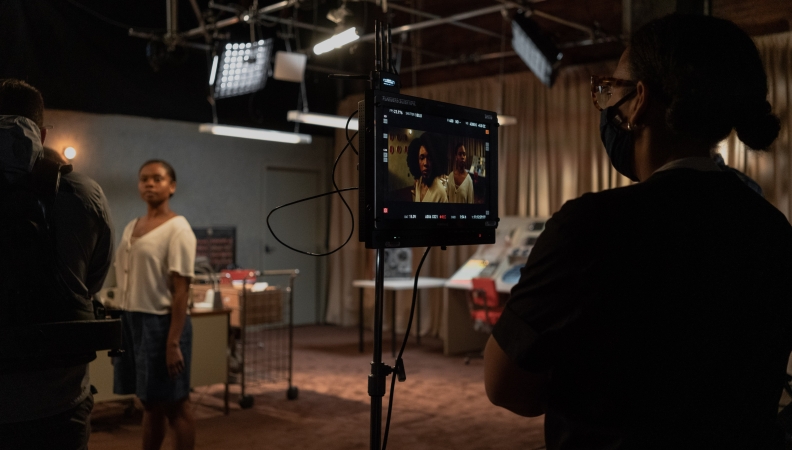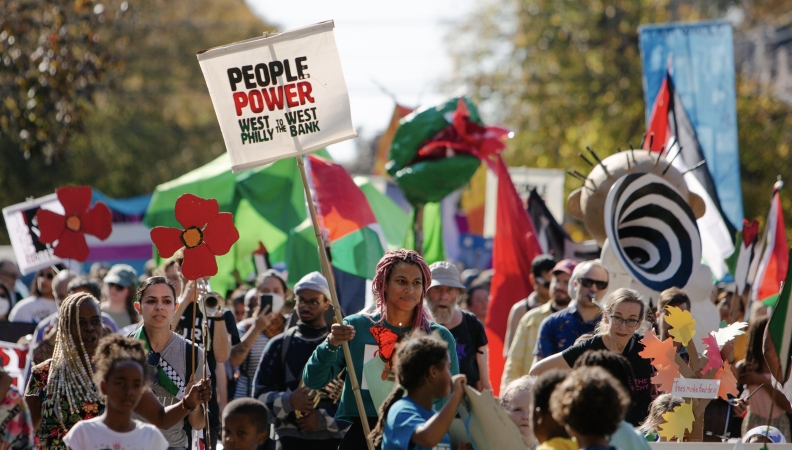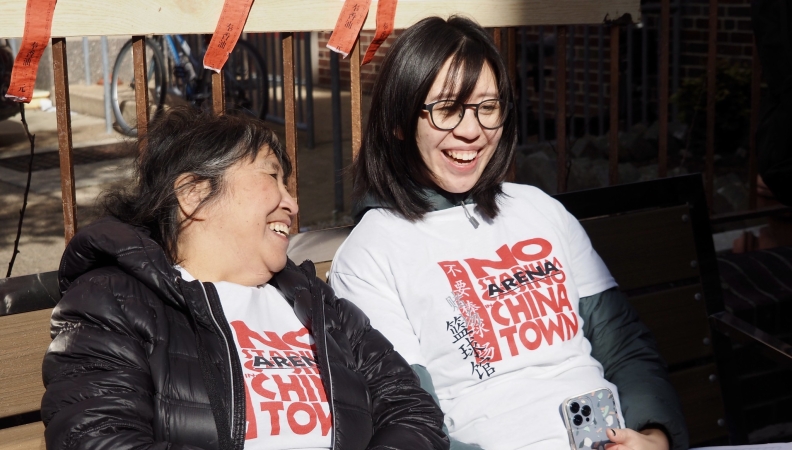Media for Movements: Philanthropy supporting narrative power for social justice
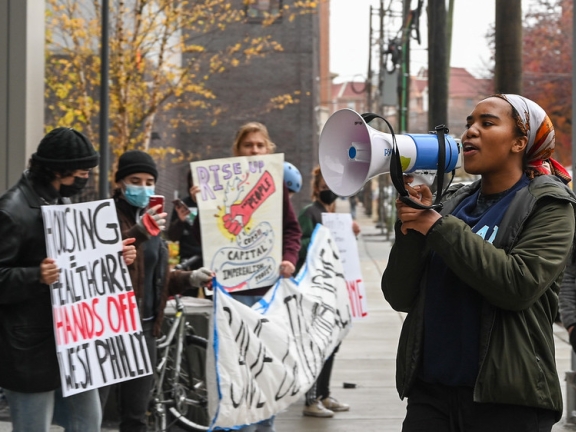
The following is a conversation between IPMF President, Molly de Aguiar, and Movement Alliance Project's Executive Director, Bryan Mercer.
Movement Alliance Project (MAP) serves as the backbone to a growing social justice movement ecosystem throughout the Philadelphia region. Established in 2005, the mission and work of MAP (formerly Media Mobilizing Project) was shaped by the need of independent media to confront the powerful narratives that underlie Philadelphia's history of persistent racial injustice and economic inequalities. Their strategies included convening coalitions and strategic alliances, and leading groundbreaking projects seeking to understand the use and abuse of new media tools to tell the story of the community. Today, the organization is using its expertise to support and build movement infrastructure in Philadelphia by collaborating with organizations and alliances to develop strategy, share their hard-won political expertise, and host convenings to strengthen connections and solidarity across the region.
Independence Public Media Foundation (IPMF) made a $2 million, three-year general operating support grant to MAP’s work of Black-led movement building and strengthening the region’s social justice ecosystem. In our nearly four years as a foundation, this is the largest grant we’ve made. The process for reviewing and approving the grant surfaced internal disagreement about our role in supporting grassroots movement building. We agreed that stories are fuel for social justice movements, but with finite resources, we debated whether we had the resources to support and strengthen the infrastructure for social justice movements to thrive.
Ultimately we decided that MAP’s unique position in the region as a central organization supporting many different social justice movements, as well as their deep history with and knowledge of community storytelling to catalyze movements, was an investment that had the potential to lift up and strengthen the work of many of our grantees.
I sat down with my colleague Bryan Mercer, the executive director of MAP, to talk about MAP’s history and approach to media.
Molly de Aguiar: Bryan, how would you describe MAP’s view of the role of media in grassroots organizing?
Bryan Mercer: Our understanding of the role of media in grassroots organizing is not one-sided but as a powerful tool in creating norms and consent. The stories we hear reinforce deeper truths that we hold, values that we use to understand the world around us. Media and the stories we tell can tap into our suspicion and distrust of our neighbors, like the nightly news crime beat invokes. Stories can also give a sense of hope and possibility, like first hand accounts of resilience and collective action.
Our work was inspired by efforts to democratize the media in the mid-nineties. An important discussion at that time was about how often the media is constructed around flaunting the details of wealthy and powerful—their desires, their romances, their diets and fashion—but when someone dies or is killed, the stories focus on everyday people. The message of the media is that the lives of those who aren't rich and famous are disposable.
This is a media landscape (trend/practices) that is still very much with us, but has also shifted to include social media. So, unfortunately, one of the largest shifts since the mid-nineties is that the media is now also a tool for people to more readily demonstrate their aspirations to be rich and famous.
However, at the same time new media has also been a tool to show more of everyday life and make possible moments like the 2020 Black Uprisings, Black Lives Matter, or Occupy Wall Street.
In as much as organizing is about hope, vision, and believing that another world is possible and necessary, the media of grassroots organizing must be about making that alternative tangible and expanding the political imagination. Tapping into the deeper narratives and values that we all hold, like wanting dignity for our family, of care and empathy for our neighbors, for the next generation to live better than we do. Media in grassroots organizing can overcome the isolation that is felt from the over saturation of stories about fear and cut-throat competition, and respond by cultivating connection. Movements begin with the telling of untold stories as we've long said at MAP.
Media, narrative, and values are contested terrain. Free speech means little without the means to be heard, and the platforms that define media are not at all public, but bought up by billionaires and enabled by those with political and social capital. Our organizing has to consider that too.
We don't just get to tell our stories, we also have to organize for our stories to be heard.
Molly: Your last point—that stories have to be connected to organizing as we fight for justice and equity—is a topic that we discuss at IPMF frequently. Can you share an example of a coalition or campaign whose narrative shift work is one you have looked to for lessons and inspiration? What does this work look like when it’s at its best?
Bryan: Community organizers know that narrative strategy needs to be a part of their work, and there are some great national leaders helping to drive that work forward who we take a great deal of lessons and inspirations from—groups like ReFrame, The Center for Story Based Strategy, and Media Justice. More recently I've also seen the critical recognition that narrative strategy alone won’t provide lasting wins without the organizing strategies to maintain and build on those wins.
What groups are learning is that the power to bring out large numbers of people for a cause is a lot easier and more effective if you can win the battle of the story, the struggle of good sense over common sense.
One example of a brilliant narrative strategy that is on my mind right now was the effort to stop the opening of a casino in center city Philadelphia from about 2008 to 2011. This was organizing that I got to see first hand as I moved back to Philly after college and helped to document community led actions as a part of our early work as Media Mobilizing Project. The original plan for the first casino licensed to open in Philly was to locate that casino in Chinatown, but it was stopped because the Chinatown community, led by groups like Asian Americans United (AAU), built a broad reaching coalition that city planners could not ignore. The ability to build such a coalition, and turn what could have easily been a not in my backyard kind of fight to one relevant for the whole city, was calling that effort the "No Casino in the Heart of the City Coalition". The Chinatown community took their community concern and told a story that was about all of Philadelphia, that helped to question what type of development was going into the heart of Philly, a neighborhood that impacts everyone who lives and who visits here. In their narrative about the fight they helped Philadelphians imagine what else is needed for a neighborhood that is used by everyone who calls Philly home.
This insight from organizations like AAU is especially relevant today as the Philadelphia 76ers propose to locate a new basketball arena in that same neighborhood. A neighborhood where we now share offices with other social movement organizations. Once again the Chinatown community is building a broad coalition to oppose a development that threatens the existence of their working class neighborhood, and doesn't bring the type of clear benefits that longterm residents of Philadelphia deserve. This time they are making a powerful narrative intervention of reminding onlookers that this arena proposal is not new in its attempt to displace their community. Organizers, putting to use a strong narrative strategy, brought back the original t-shirts from those earlier fights with the phrase "No Stadium in Chinatown" and crossed out "Stadium" for "Arena" as a powerful visual of the ongoing threat the community faces from outsized and uneven development.
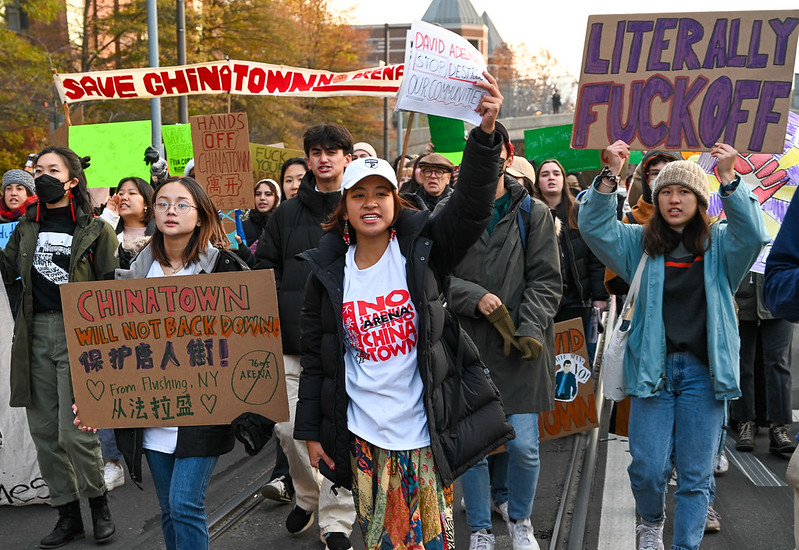
Molly: Even after 17 years in philanthropy, I feel like I am learning all the time the depth and breadth of resources that organizations and movements need to win durable change. Can you shed some light on this for other funders who might be reading this interview?
Bryan: We’re learning ourselves and experiencing some of the challenges that exist in advancing narrative change work, particularly for smaller community organizations doing social justice work. Funders interested in media can support these organizations by funding more than the current ability for our movements to produce media, but also investing in building pipelines for leadership and skill development among organizers that are necessary for narrative change strategy. This is important for ensuring that narrative strategy is integrated with the overall organizing strategy.
Narrative strategy is an important piece of the puzzle, but it also isn't a silver bullet. Events of the last few years should help us recognize that we have to address serious faults of the corporate media landscape, which are amplified in a highly connected digital society. Just as media and narrative strategy are complicated terrains, no single tactic is a panacea for advancing justice, rights and equity in the United States. Instead, social movements have to build the capacity to operate on every front of power—narrative alongside organizing, growing leadership, and creating lasting institutions. We need strategy and plans at the scale of the problems society faces.
Molly: What do Black-led movements need from funders?
Bryan: Providing stable funding and flexibility to Black-led movements is one of the most important ways the philanthropic community can support us. There's a history here, that is much longer than I probably have time to share now, that Black-led movements in the US are recovering from and remaking ourselves after more than a generation of concerted attacks. The promise of the Civil Rights Movement and Black Power Movement, along with the other critical social movements of the 20th century were decimated over the last 50 years. There's been consistent attempts and significant success at undermining the rights and freedoms those movements won, and neoliberalism alongside a reactionary white supremacist agenda have tried to stop the resurgence of those traditions of struggles. However, we've seen with recent protest movements and uprisings that the history of struggle is not lost, and people—particularly young people—politicized in those recent uprisings are drawing on that history for inspiration.
Funders who care about justice and freedom should understand that a shift doesn't take place within the confines of a grant cycle. The new leaders and movement organizations of today need the stability to: (1) develop strategy, (2) get clarity on an agenda for the long term with the context and lessons of history in mind, and (3) foresight beyond the immediate fights in front of us. That requires the flexibility to experiment. Experiment with viewing success as a space where honesty, learning and rigorous debate take place. Something that makes those conditions possible is if, similar to the period of the civil rights movement, there are people of conscience with wealth who will gift that wealth with long-term stability and flexibility for justice movements to be bold.
So the support that is needed for Black-led movements to be effective are things like:
- Listening to the groups on the ground about what they need to deal with the challenges they are trying to solve. America has a very deep and pervasive history of racial inequality and the manifestations are manifold and complex.
- Funding the work for those groups to develop strategy.
- Remembering that good strategy takes time, and will mean those groups have to make hard choices and say no.
- Having the patience to recognize that theory is not a promise. Like other now-established organizations before them, community-led organizations need the grace to succeed and to fail.
- Most importantly, they also need that grace so they can get back up and use those lessons to be sharper and clearer on what work will bring all of us in this society closer to living our lives with dignity and justice.
Learn more about Movement Alliance Project’s work.
If you are a funder interested in supporting media making and narrative change work, but need some advice and support, or if you would like to collaborate or share ideas, please get in touch with IPMF: info@independencemedia.org.
Photo credits: Joe Piette via Flickr

